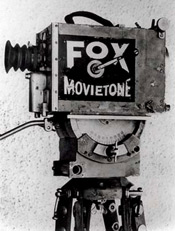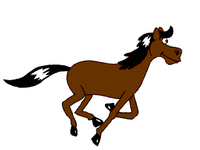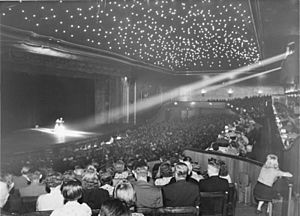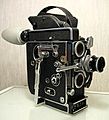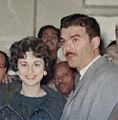Movie facts for kids
Movies, also called films, are a way to tell stories or share information using moving pictures and sounds. People all over the world watch movies for fun. Some movies make people laugh, while others might make them cry or feel scared.
Most movies are first shown on large screens at movie theaters. After a few weeks or months, you can watch them at home. They become available on pay TV, cable television, DVDs, or through streaming services. Later, they might even be shown on regular television channels.
A movie camera or video camera takes many pictures very quickly. It usually takes 24 or 25 pictures (called frames) every second. When a movie projector, computer, or television shows these pictures at the same speed, it looks like the things in the pictures are really moving! Sound is either recorded at the same time or added later. Movie sounds include people talking (called dialogue), music (the "soundtrack"), and sound effects. Sound effects are the sounds of actions happening in the movie, like doors opening or guns firing. In the past, cameras used photographic film. Even today, movies are often still called "films," even if no actual film is used.
Contents
How Movies Come to Life
Movies are made through a step-by-step process involving many talented people.
From Script to Screen
First, a screenwriter writes a script. This script is the story of the movie, including what the actors will say and do. Then, a producer takes charge. The producer hires all the people needed to work on the movie. They also find the money to pay for the actors and equipment. Producers often get money from banks or from investors who lend money for the movie. Some producers work for big movie studios, while others are independent.
Actors and the director read the script to understand their roles. Actors learn the words they will say and the actions they need to perform. The director guides the actors. A cameraman then films them with a motion picture camera.
After filming is done, an editor puts all the moving pictures together. They arrange them to tell the story in the right order and within a certain time. Audio engineers and sound engineers record music and sounds. They then combine these sounds with the moving pictures.
When the movie is finished, many copies are made. These copies are sent to cinemas. In a movie theater, a movie projector shines the movie onto a large projection screen. This is at the front of the room where the audience watches. At the same time, the dialogue, sounds, and music play through loudspeakers.
Different Kinds of Movies (Genres)
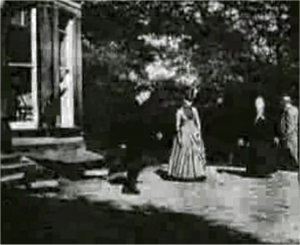
A genre is a word for a type or style of movie. Movies can be fictional (made up), based on true events, or a mix of both. Even though many movies are made each year, most follow a few basic plots or stories. Some movies even combine two or more genres.
- Action movies are full of exciting scenes. These often include car chases and gun fights, with stuntmen doing dangerous moves. They usually have heroes and villains. War and crime are common topics. Action movies are often easy to watch because their stories are usually simple. For example, in Die Hard, terrorists take over a building. A single hero tries to save everyone. Action movies usually don't make you cry, but if they also have drama, they might involve some emotion.
- Adventure movies often feature a hero. This hero goes on a journey or quest to save the world or people they care about.
- Animated movies use drawings or computer-made images to tell a story. In the past, these movies were drawn by hand, one frame at a time. Now, most are made using computers.
- Buddy movies involve two heroes. One might need to save the other, or both must overcome challenges together. Buddy movies often include comedy. They also show emotion because of the close friendship between the "buddies."
- Comedies are funny movies. They show people being silly, doing unusual things, or being in funny situations that make the audience laugh.
- Documentaries are movies that are about real people and real events. They are almost always serious. They might cover emotional topics, like cruelty.
- Dramas are serious movies. They are often about people falling in love or making big life choices. They tell stories about relationships between people. Usually, one or two main characters (played by actors) have to get past an obstacle to get what they want.
- Film noir movies are detective dramas from the 1940s. They are usually about crime and violence.
- Family movies are made for everyone in the family. They are mainly for children but often fun for adults too. Disney is famous for its family movies.
- Horror movies use fear to excite the audience. The music, lighting, and sets (man-made places where the movie is filmed) are all designed to make you feel scared.
- Romantic Comedies (Rom-Coms) are usually love stories. They are about two people from different worlds who must overcome problems to be together. Rom-Coms are always light-hearted, but they can include some emotion.
- Science fiction movies are set in the future or in outer space. Some use these settings to explore big questions about life or how we should think about things. Science fiction movies often use special effects to create images of alien worlds, spaceships, and strange creatures.
- Thrillers are usually about a mystery, a strange event, or a crime that needs to be solved. The audience is kept guessing until the very end. There are often "twists" (surprises) in the story.
- Western movies tell stories about cowboys in the western United States in the 1800s. They are often like Action movies but with historical costumes. They may or may not include Native Americans.
- Suspense movies keep you on the edge of your seat. They often have many twists that can confuse the viewer.
- Fantasy movies include magic and impossible things that real humans cannot do.
The Business Side of Movies
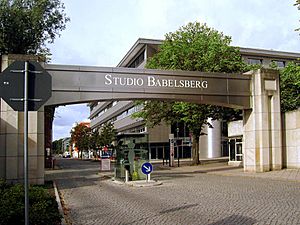
Many movies don't make money, but some earn hundreds of millions in profit. The movie industry has always been led by a small number of big studios. Examples include MGM, Warner, Columbia, and Paramount.
There are many large companies that provide services for movies. These include special effects, lighting, and set building. Many workers in these companies belong to trade unions. These unions help decide how much their members should be paid. Many smaller companies also offer services, like music studios that record movie soundtracks and companies that create CGI. Finally, there are movie distribution companies that send movies around the world. Advertising companies also promote movies to make people want to see them.
Big Blockbusters vs. Independent Films
Movies with famous stars and large budgets (lots of money) are made to appeal to many people. The goal is for millions to pay to see them. These very expensive movies are called blockbusters. Special effects can greatly increase a movie's cost, especially the newest CGI effects. But people expect them, and every blockbuster tries to be more impressive than the last. Even in 2008, some movies cost up to $200 million to make. Very successful movies can make many times that amount in profit. This is why studios keep making them. Blockbuster movies are heavily promoted through television advertising, billboards, and internet sites. In blockbusters, there is usually a happy ending. All problems in the story are solved, and almost everyone (except the villain) lives happily ever after. Some movies are so successful that studios keep making sequels. These are new movies with the same characters and basic stories.
On the other hand, there are independent, art, or Indie movies. These are usually made by small movie companies or groups of people who don't have much money. For example, The Blair Witch Project cost only about $60,000 to make. But it earned around $200 million from tickets and DVD sales. Movies like this are very unusual. They often become popular through "word of mouth" advertising. They become "cult" favorites, meaning they are popular with a specific group but not necessarily with everyone. Independent movies often tell more creative or unusual stories. They might also have sad endings that big studios avoid. This is because studios are unsure how the public will react to them. Indie films rarely make a lot of money. But if one is very successful, big studios might quickly offer the people involved a lot of money to make another movie. Often, this new movie, with its big budget and stars, might be less successful than the first.
Related pages
- Big Ten (movie studios), America's ten largest movie studios
Images for kids
-
Salah Zulfikar, a popular actor from the golden age of Egyptian Cinema
-
The Lumière Brothers, who were among the first filmmakers
-
Salah Zulfikar and Faten Hamama at the premiere of Bain Al-Atlal ("Among the Ruins") in Cairo, 1959


